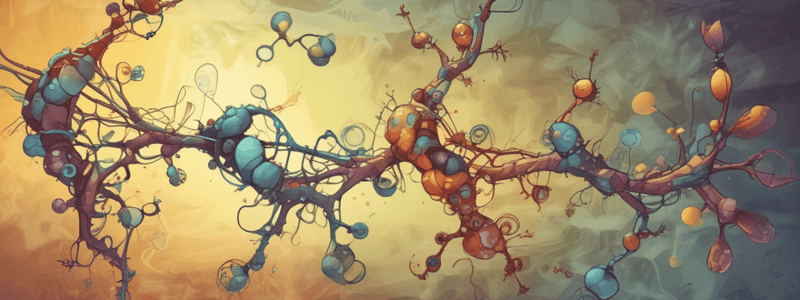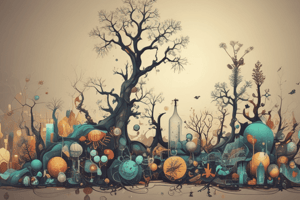Podcast
Questions and Answers
Protobionts are capable of directing the synthesis of new copies of themselves.
Protobionts are capable of directing the synthesis of new copies of themselves.
False (B)
RNA synthesis is the first stage of chemical evolution.
RNA synthesis is the first stage of chemical evolution.
False (B)
Natural selection operated on the different RNAs during the protobiont synthesis stage.
Natural selection operated on the different RNAs during the protobiont synthesis stage.
True (A)
Prokaryotic cells evolved from the diversity of protobionts.
Prokaryotic cells evolved from the diversity of protobionts.
Proteins can serve as templates for synthesis because of specific base pairings between complementary nucleotides.
Proteins can serve as templates for synthesis because of specific base pairings between complementary nucleotides.
Melvin Calvin introduced the term 'biological evolution' in the context of chemical evolution.
Melvin Calvin introduced the term 'biological evolution' in the context of chemical evolution.
The 'Calvin cycle' explains the process of chemical evolution on the primitive Earth.
The 'Calvin cycle' explains the process of chemical evolution on the primitive Earth.
Chemical evolution gave rise to the first forms of eukaryotic life.
Chemical evolution gave rise to the first forms of eukaryotic life.
The building block molecules formed during chemical evolution included amino acids, fatty acids, and nucleobases.
The building block molecules formed during chemical evolution included amino acids, fatty acids, and nucleobases.
The Big Bang theory proposes that the building block molecules were formed on Earth through endogenous synthesis.
The Big Bang theory proposes that the building block molecules were formed on Earth through endogenous synthesis.
The evolution of photosynthesis utilized H2O to convert CO2 to organic molecules.
The evolution of photosynthesis utilized H2O to convert CO2 to organic molecules.
ATP is a by-product of oxidative metabolism.
ATP is a by-product of oxidative metabolism.
The development of oxidative metabolism occurred before photosynthesis.
The development of oxidative metabolism occurred before photosynthesis.
Glycolysis is a semi-conservative metabolic energy pathway that uses ATP.
Glycolysis is a semi-conservative metabolic energy pathway that uses ATP.
The release of O2 as a by-product of photosynthesis led to the development of glycolysis.
The release of O2 as a by-product of photosynthesis led to the development of glycolysis.
Plant cells are more diverse than animal cells.
Plant cells are more diverse than animal cells.
Ground tissue, dermal tissue, and vascular tissue are the three main tissue systems found in animal cells.
Ground tissue, dermal tissue, and vascular tissue are the three main tissue systems found in animal cells.
Epithelial tissue forms sheets that cover the surface of and line internal organs in plants.
Epithelial tissue forms sheets that cover the surface of and line internal organs in plants.
Nervous tissue is composed of nerve cells and are highly specialized for signal transmission throughout the body in plants.
Nervous tissue is composed of nerve cells and are highly specialized for signal transmission throughout the body in plants.
Xylem and phloem are responsible for the transport of oxygen and carbon dioxide in plants.
Xylem and phloem are responsible for the transport of oxygen and carbon dioxide in plants.
Parenchyma cells are a type of dermal tissue found in plants.
Parenchyma cells are a type of dermal tissue found in plants.
Collenchyma and sclerenchyma are two types of xylem cells found in plants.
Collenchyma and sclerenchyma are two types of xylem cells found in plants.
Blood is a type of tissue found in plants that functions in oxygen transport, immunity, and inflammatory reactions.
Blood is a type of tissue found in plants that functions in oxygen transport, immunity, and inflammatory reactions.
Muscle tissue provides structure and elasticity to the body in plants.
Muscle tissue provides structure and elasticity to the body in plants.
The human body is composed of fewer than 100 different kinds of cells.
The human body is composed of fewer than 100 different kinds of cells.
Flashcards are hidden until you start studying




